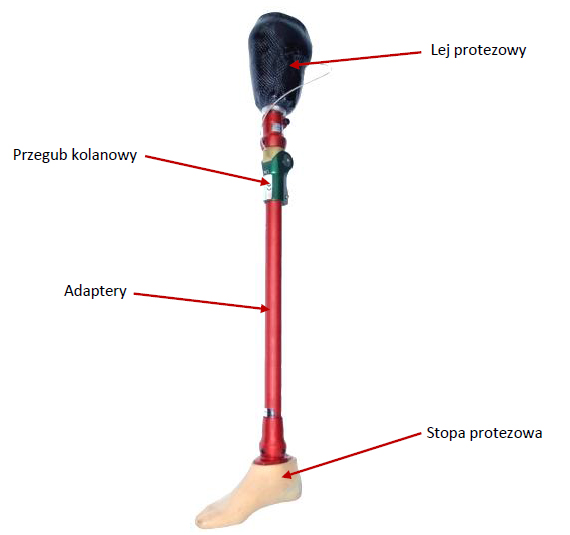-
Koszyk jest pusty!
MENU
Dzieci od najmłodszych lat chcą być samodzielne, dotrzymywać kroku dorosłym oraz imponować swoim rówieśnikom. Są ciekawe otaczającego ich świata. Po to aby się z nim zmierzyć zarówno podczas zabawy jak i codziennego życia potrzebne są im udogodnienia, które zapewnią im komfort prawidłowego funkcjonowania.
Lej protezowy – element ten jest wykonywany indywidualnie dla każdego Pacjenta w zakładzie ortopedycznym. Odwzorowuje on dokładnie kształt kikuta. Jest jednym z najważniejszych elementów protezy, ponieważ stanowi połączenie pomiędzy protezą, a ciałem amputanta i stanowi o komforcie używanej protezy. Wyróżniamy różne typy lejów ze względu na rodzaj amputacji, materiał leja oraz sposób jego przylegania do kikuta. Tendencja kikuta do zmiany swojej objętości stanowi jeden z największych problemów w protezowaniu.
Przegub kolanowy - Przeguby kolanowe w protezach modularnych są bardzo istotnym elementem. Przegub kolanowy powinien zagwarantować pacjentowi stabilność protezy zarówno podczas stania jak i fazy podporu w trakcie chodzenia. W głównej mierze odpowiada on za bezpieczeństwo pacjenta. Steruje on także ruchem podudzia podczas fazy przenoszenia oraz powrotu do pozycji wyjściowej. W dużym stopniu od rodzaju stawu kolanowego zależy dynamika chodu pacjenta. Kolano protezowe powinno uwzględniać kilka podstawowych aspektów, a zagwarantowanie psychicznej pewności oraz odpowiedniej dynamiki pracy przegubu skutkuję chodem zbliżonym do naturalnego. Kolana protezowe możemy podzielić ze względu na ilość osi (jedno bądź wieloosiowe) oraz na mechanizm jaki wykorzystują. Wyróżniamy mechanizmy: policentryczne, pneumatyczne, hydrauliczne oraz sterowane elektronicznie.

Adaptery – Są to elementy łączące ze sobą poszczególne moduły konstrukcji. Mogą być wykonane z różnego rodzaju materiałów. Możemy je podzielić ze względu na to czy są bierne czy też funkcjonalne. Elementy bierne to na przykład adaptery rurowe, łączące, adaptery do laminacji – łączą one tylko poszczególne moduły protezy, nie spełniają żadnej funkcji. Natomiast adaptery funkcjonalne stwarzają protezie nowe możliwości, są to adaptery obrotowe, przesuwne, amortyzatory.
Stopa protezowa - Bardzo ważnym elementem protezy modularnej jest stopa protezowa. To, w jaki sposób zachowa się podczas kontaktu z podłożem będzie miało wpływ na zachowanie całej protezy. Z mechanicznego punktu widzenia stopy możemy podzielić na dwie proste kategorie. Są to stopy z ruchomym stawem skokowym oraz sztywne stopy pozbawione przegubu. Możemy także dokonać podziału ze względu na tworzywo z którego zostały wykonane. Istnieje bardzo dużo takich rozwiązań, co jest ogromną zaletą systemu protez modularnych w których dzięki temu można dopasować każdy mechanizm indywidualnie do zapotrzebowania użytkownika. Ze względu na rodzaj tworzywa, z którego zostały wykonane możemy wyróżnić stopy ze stawem mechanicznym, pneumatycznym, hydraulicznym, pneumatyczno hydraulicznym, oraz najbardziej popularne stopy z włókna węglowego. Najnowsze osiągnięcia to stopy elektroniczne z wbudowanym mikroprocesorem.
W ofercie naszej firmy znajduje się wiele adapterów protezowych dla dzieci o różnym przeznaczeniu. Są to adaptery stopy protezowej, adaptery do laminacji leja protezowego, śrubowe, tulejowe, zaciskowe, przedłużające oraz rurowe.
Zaopatrzenie ortopedyczne dla dzieci zostało stworzone na wzór wyrobów systemu modularnego. Są to przede wszystkim wyroby bezpieczne i stabilne, dostosowane do specyficznych potrzeb dzieci.